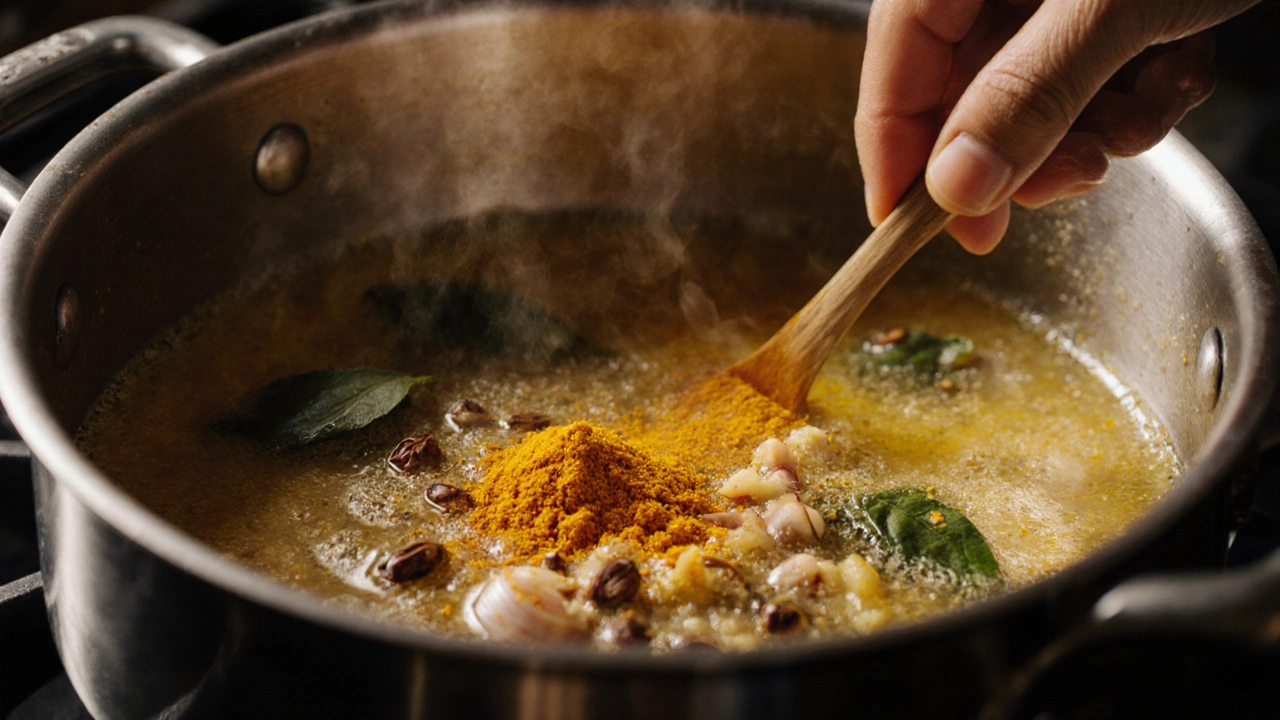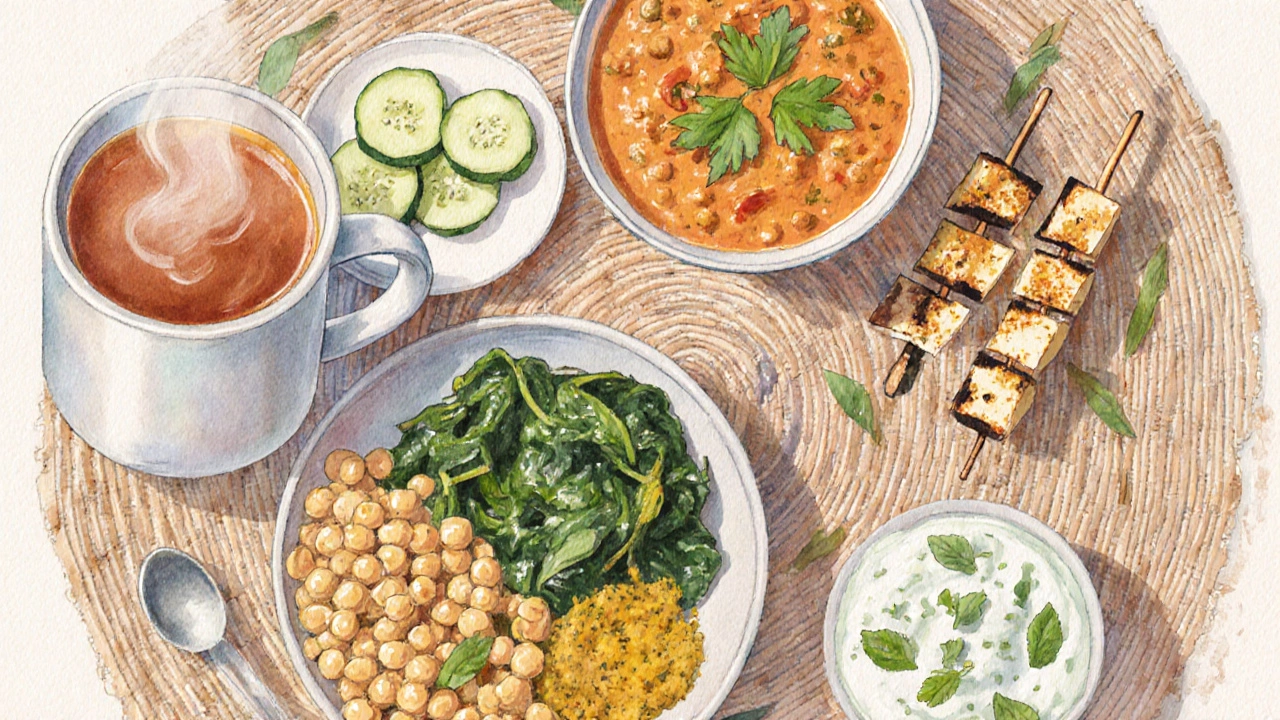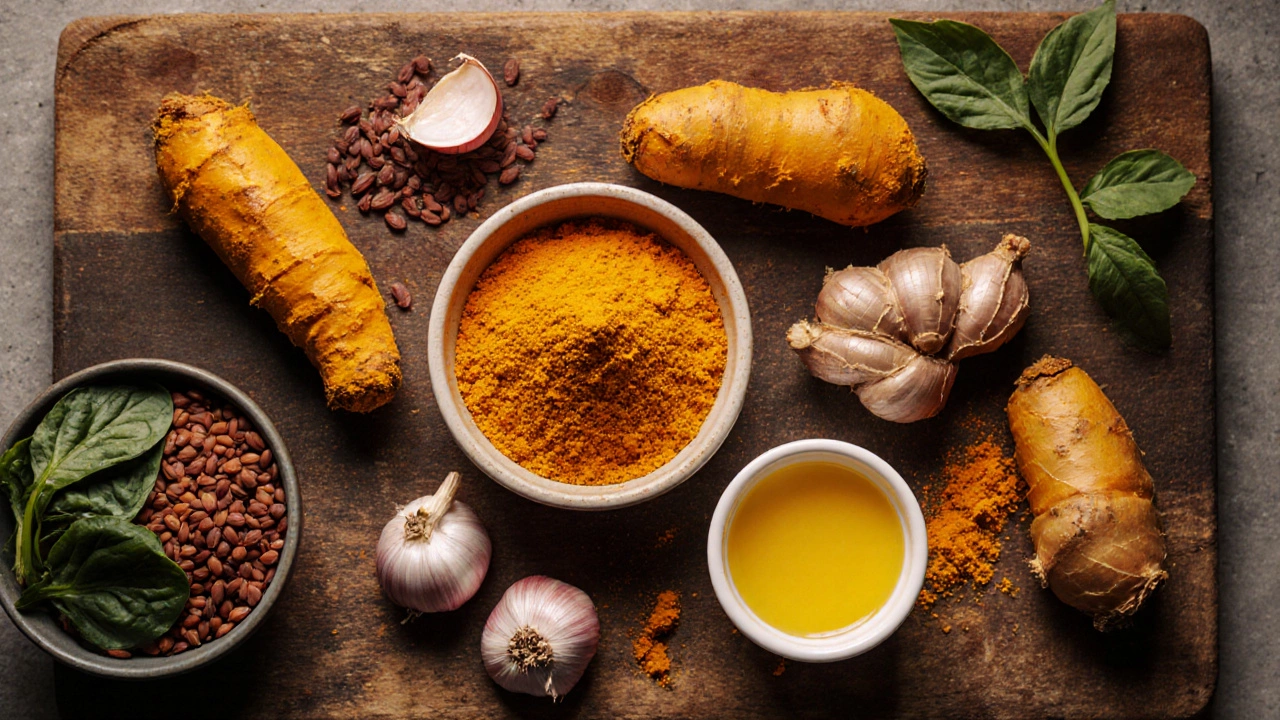Anti-Inflammatory Intake Calculator
Calculate how much of these key anti-inflammatory ingredients you're currently consuming daily and see how close you are to optimal levels. Based on research from the article.
Recommended amounts for maximum anti-inflammatory benefit:
- Turmeric ½ tsp (2g)
- Ginger 1 inch fresh (5g)
- Garlic 2-3 cloves
- Spinach 1 cup cooked
- Lentils (Dal) ½ cup cooked
Turmeric
Ginger
Garlic
Spinach
Lentils (Dal)
Your Results
When joint pain, stubborn tummy aches, or chronic swelling start to ruin your day, the first place to look isn’t a pharmacy-it’s your plate. Indian cuisine is packed with spices and vegetables that naturally dial down inflammation. Below you’ll find the most effective Indian foods, why they work, and simple ways to bring them into everyday meals.
Key Takeaways
- Turmeric, ginger, garlic, lentils, spinach, curry leaves and ghee are the star anti‑inflammatory ingredients.
- Combine spices with a healthy fat (like ghee) to boost curcumin absorption.
- A simple dal recipe can deliver protein, fiber, and anti‑inflammatory power in under 30 minutes.
- Pair one anti‑inflammatory dish with a side of fresh veggies for a balanced day‑long menu.
- Stay consistent-daily intake of these foods yields the best results for reducing chronic inflammation.
Why Inflammation Needs a Kitchen Fix
Inflammation is the body’s alarm system. Short bursts help heal cuts, but long‑term inflammation fuels arthritis, heart disease, and even mood disorders. Diet accounts for roughly 30% of chronic inflammation risk, according to a 2023 meta‑analysis of 45 nutrition studies. Swapping processed snacks for whole, spice‑rich Indian foods can cut inflammatory markers like C‑reactive protein (CRP) by up to 20%.
Signature Anti‑Inflammatory Spices in Indian Cooking
Indian kitchens rely on a handful of spices that double as medicine.
Turmeric is a bright yellow root spice rich in curcumin, known for its powerful anti‑inflammatory properties. Curcumin blocks NF‑κB, a protein that triggers inflammatory pathways. Pair turmeric with a pinch of black pepper to increase absorption by 2000%.
Ginger is a rhizome that contains gingerol, which reduces prostaglandin synthesis and eases joint pain. Fresh ginger added to soups or teas can lower pain scores in osteoarthritis patients by 30% after eight weeks.
Garlic is a bulb with allicin that suppresses inflammatory cytokines and improves blood flow. Regular garlic use is linked to a 15% drop in CRP levels.
Other supporting spices-curry leaves, mustard seeds, fenugreek, and cinnamon-add layers of antioxidants that work synergistically.
Protein‑Packed Anti‑Inflammatory Dal
Dal (lentils) delivers plant‑based protein, soluble fiber, and a host of phytochemicals. When cooked with turmeric, ginger, and a dash of ghee, it becomes a nutritional powerhouse.
Lentils (Dal) are small legumes that provide 18g of protein per cooked cup and are high in polyphenols that fight inflammation. Below is a quick, 30‑minute recipe.
- Rinse 1cup red lentils; set aside.
- Heat 1tbsp ghee in a pot; add ½tsp cumin seeds and a few curry leaves until they sizzle.
- Add 1tsp grated ginger, 2cloves minced garlic, and 1tsp turmeric; stir for 30seconds.
- Pour in the lentils, 3cups water, and a pinch of salt. Bring to a boil, then simmer 15minutes.
- Finish with a splash of lemon juice and freshly chopped cilantro.
This dish supplies about 250calories, 12g fiber, and a solid dose of curcumin-all without any heavy cream.

Green Goodness: Spinach and Curry Leaves
Spinach is a leafy green loaded with lutein, kaempferol and omega‑3 fatty acids that dampen inflammatory signals. Saute a handful with mustard seeds, curry leaves, and a teaspoon of ghee for a quick side.
Cooking Fat That Helps, Not Hurts
Ghee is clarified butter rich in short‑chain fatty acids and butyric acid, which support gut health and lower inflammation. Because it tolerates high heat, ghee is perfect for frying spices and extracting curcumin.
Quick Anti‑Inflammatory Indian Meal Plan
- Breakfast: Turmeric‑ginger tea (boil water, add ½tsp turmeric, 1inch ginger, a pinch of black pepper, and honey).
- Mid‑morning snack: Fresh cucumber slices with a sprinkle of chaat masala.
- Lunch: Red lentil dal (recipe above) served with a side of sautéed spinach and curry leaves.
- Afternoon snack: A small handful of roasted chickpeas tossed in turmeric and sea salt.
- Dinner: Grilled paneer marinated in yogurt, turmeric, and garlic, paired with a cucumber‑mint raita.
Sticking to this plan for just two weeks can noticeably reduce joint stiffness and improve energy levels.

How the Ingredients Stack Up
| Ingredient | Key Anti‑Inflammatory Compound | Typical Daily Amount for Benefit |
|---|---|---|
| Turmeric | Curcumin | ½tsp (≈2g) |
| Ginger | Gingerol | 1inch fresh root (≈5g) |
| Garlic | Allicin | 2‑3 cloves |
| Spinach | Lutein & Kaempferol | 1 cup cooked |
| Lentils (Dal) | Polyphenols | ½ cup cooked |
Common Pitfalls & How to Avoid Them
- Skipping the fat: Curcumin is fat‑soluble. Always cook turmeric with a teaspoon of ghee or oil.
- Over‑cooking spices: Burnt garlic or ginger turns bitter and loses anti‑inflammatory power. Add them just before the liquid hits the pan.
- Relying on processed mixes: Store‑bought spice blends often contain excess salt and additives that offset benefits.
- Ignoring variety: Rotate between turmeric, ginger, garlic, and leafy greens to cover a broader range of phytochemicals.
Frequently Asked Questions
Can I use regular butter instead of ghee?
Yes, but ghee tolerates higher heat and contains more short‑chain fatty acids, which boost gut health and inflammation control. If you choose butter, keep the temperature below 150°C to avoid burning.
How much turmeric is safe to eat daily?
Around ½teaspoon (2grams) of ground turmeric per day is considered safe for most adults. Higher doses should be discussed with a healthcare professional, especially if you take blood thinners.
Is fresh ginger better than powdered?
Fresh ginger retains more gingerol and vitamin C, making it slightly more potent. Powdered ginger is convenient and still effective for most cooking needs.
Do lentils cause inflammation for some people?
Some individuals with specific bean sensitivities may experience gas or gut irritation, but overall lentils are considered anti‑inflammatory due to their fiber and polyphenol content. Soak them well and rinse before cooking to reduce the effect.
Can these foods replace medication?
They’re powerful allies, but they shouldn’t replace prescribed meds without a doctor’s guidance. Use them as a daily supportive strategy alongside any treatment plan.
Incorporating the right Indian foods isn’t a quick fix; it’s a sustainable lifestyle tweak. Start with one anti‑inflammatory recipe a week, watch how you feel, and gradually expand. Your joints, gut, and heart will thank you.
